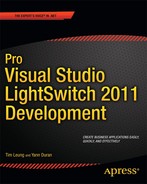Foreword
All businesses use software to automate their business functions. At their heart, such applications are about gathering, storing, and processing data, and so could perform tasks that we typically consider under the rubric of business applications—for example, tracking finances or assets (as in ERP software). But it also includes the process of software development, systems management, or anything else involving data. There is a lot of this business software out there, a lot more being written, and even more that people wish they had the time, budget, and skill to write.
Building such software involves two concerns: the business problem to be solved (the domain) and the technology into which a solution is rendered. First you have to have one person who understands both the domain and the technology necessary to render it into software, or you have to have a team with a mix of skills. That's enough to kill many small projects.
Assuming you can get the right people together, the technologist then spends a great deal of time on issues that have nothing to do with the business problem being solved, including UI, protocols, business logic mechanisms, security, integration with Microsoft Office, and much, much more. One needs a good deal of skill, time, inclination, and budget to get a project accomplished.
To help people write business applications faster, we wrote Microsoft Visual Studio LightSwitch, the simplest way for developers of all skill levels to develop business applications for the desktop and cloud. Using LightSwitch, the core technical problems are solved, and a lot of projects—which without LightSwitch would have never seen the light of day—are now in production.
Pro Visual Studio LightSwitch 2011 Development provides a conceptual and practical introduction to many core LightSwitch building blocks, including importing and defining data schema, designing queries and screens, validating data, authenticating and authorizing application users, and deploying the final product.
However, the challenge with rapid application development environments is that they're great at solving the problems they anticipated, but what if you need to do more? Happily, LightSwitch was designed without the glass ceiling that constrains the tools of the 4GL generation, so the full power of Visual Studio is available to you if you want it—the limit is your imagination.
Tim and Yann have a lot of imagination, and they have explored many ways to supplement LightSwitch in this book. They offer solutions for a number of problems that LightSwitch does not address but that you may encounter as you write your applications. Theirs is a cookbook. Some recipes won't have ingredients you like, some you'll season to fit your taste, some will open possibilities you hadn't even considered, and some you'll use as is. A sampling includes sending email, creating reports, and implementing auditing.
They share a passion with the LightSwitch team and with their readers: to build great business applications, fast. Together we can make businesses more successful through software.
Steve Anonsen, Distinguished Engineer, Microsoft Visual Studio
John Rivard, Partner Software Design Engineer, Microsoft Visual Studio
